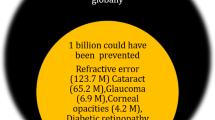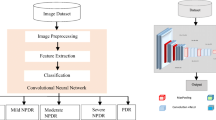Abstract
Glaucoma is an ocular disease that is the leading cause of irreversible blindness due to an increased Intraocular pressure resulting in damage to the optic nerve of eye. A common method for diagnosing glaucoma progression is through examination of dilated pupil in the eye by expert ophthalmologist. But this approach is laborious and consumes a large amount of time, thus the issue can be resolved using automation by using the concept of machine learning. Convolution neural networks (CNN’s) are well suited to resolve this class of problems as they can infer hierarchical information from the image which helps them to distinguish between glaucomic and non-glaucomic image patterns for diagnostic decisions. This paper presents an Artificially Intelligent glaucoma expert system based on segmentation of optic disc and optic cup. A Deep Learning architecture is developed with CNN working at its core for automating the detection of glaucoma. The proposed system uses two neural networks working in conjunction to segment optic cup and disc. The model was tested on 50 fundus images and achieved an accuracy of 95.8% for disc and 93% for cup segmentation.












Similar content being viewed by others
References
Abdullah M, Fraz MM, Barman SA (2016) Localization and segmentation of optic disc in retinal images using circular Hough transform and grow-cut algorithm. PeerJ. 4:e2003
Algazi VR, Keltner JL, Johnson CA (1985) Computer analysis of the optic cup in glaucoma. Invest Ophthalmol Vis Sci 26(12):1759–1770
Almazroa A, Alodhayb S, Raahemifar K, Lakshminarayanan V (2017) Optic cup segmentation: type-II fuzzy thresholding approach and blood vessel extraction. Clinical ophthalmology (Auckland, NZ) 11:841
Arnay R, Fumero F, Sigut J (2017) Ant colony optimization-based method for optic cup segmentation in retinal images. Appl Soft Comput 52:409–417
Bach M (2001) Electrophysiological approaches for early detection of glaucoma. Eur J Ophthalmol 11(2_suppl):41–49
Bharkad S (2017) Automatic segmentation of optic disk in retinal images. Biomedical Signal Processing and Control 31:483–498
Chen X, Xu Y, Yan S, Wong DW, Wong TY, Liu J (2015) Automatic feature learning for glaucoma detection based on deep learning. InInternational Conference on Medical Image Computing and Computer-Assisted Intervention 2015 Oct 5 (pp. 669–677). Springer, Cham
Chen X, Xu Y, Wong DW, Wong TY, Liu J (2015) Glaucoma detection based on deep convolutional neural network. InEngineering in Medicine and Biology Society (EMBC), 2015 37th Annual International Conference of the IEEE 2015 Aug 25 (pp. 715–718). IEEE
Cheng J, Liu J, Xu Y, Yin F, Wong DW, Tan NM, Tao D, Cheng CY, Aung T, Wong TY (2013) Superpixel classification based optic disc and optic cup segmentation for glaucoma screening. IEEE Trans Med Imaging 32(6):1019–1032
Chrástek R, Wolf M, Donath K, Michelson G, Niemann H (2002) Optic disc segmentation in retinal images. InBildverarbeitung für die Medizin 2002 (pp. 263–266). Springer, Berlin, Heidelberg
Garg G, Juneja M (2018) A survey of denoising techniques for multi-parametric prostate MRI. Multimedia Tools and Applications, 1–34
Garg G, Juneja M (2018) A survey of prostate segmentation techniques in different imaging modalities. Current Medical Imaging Reviews 14(1):19–46
Goh KG, Hsu W, Lee ML, Wang H (2001) Adris: an automatic diabetic retinal image screening system. Studies in Fuzziness and Soft Computing 60:181–210
Joshi GD, Sivaswamy J, Karan K, Krishnadas SR (2010) Optic disk and cup boundary detection using regional information. InBiomedical Imaging: From Nano to Macro, IEEE International Symposium on 2010, (pp. 948–951). IEEE
Kande GB, Subbaiah PV, Savithri TS (2008) Segmentation of exudates and optic disk in retinal images. InComputer Vision, Graphics & Image Processing. ICVGIP'08. Sixth Indian Conference on 2008 Dec 16 (pp. 535–542). IEEE
Kaur R, Juneja M (2018) A survey of kidney segmentation techniques in CT images. Current Medical Imaging Reviews. 14(2):238–250
Kaur R, Juneja M, Mandal AK (2018) Computer-aided diagnosis of renal lesions in CT images: A comprehensive survey and future prospects. Computers & Electrical Engineering. 2018 Aug 22
Kaur R, Juneja M, Mandal AK (2018) A comprehensive review of denoising techniques for abdominal CT images. Multimedia Tools and Applications. 1–36
Kaur R, Juneja M, Mandal AK (2018) A hybrid edge-based technique for segmentation of renal lesions in CT images. Multimedia Tools and Applications. 1–21
Klein BE, Magli YL, Richie KA, Moss SE, Meuer SM, Klein R (1985) Quantitation of optic disc cupping. Ophthalmol. 92(12):1654–1656
Li H, Chutatape O (2003) A model-based approach for automated feature extraction in fundus images. Innull (p. 394). IEEE
Liu SP, Chen J (2011) Detection of the optic disc on retinal fluorescein angiograms. Journal of Medical and Biological Engineering 31(6):405–412
Lowell J, Hunter A, Steel D, Basu A, Ryder R, Fletcher E, Kennedy L (2004) Optic nerve head segmentation. IEEE Trans Med Imag 23(2):256–264
Lu S (2011) Accurate and efficient optic disc detection and segmentation by a circular transformation. IEEE Trans. Med. Imag. 30(12):2126–2133
Miri MS, Abràmoff MD, Lee K, Niemeijer M, Wang JK, Kwon YH, Garvin MK (2015) Multimodal segmentation of optic disc and cup from SD-OCT and color fundus photographs using a machine-learning graph-based approach. IEEE Trans Med Imaging 34(9):1854–1866
Pallawala P, Hsu W, Lee ML, Eong KGA (2004) Au-tomated optic disc localization and contour detection using ellipse fitting and wavelet transform, in ECCV, 2004, pp. 139–151
Quigley HA, Broman AT (2006) The number of people with glaucoma worldwide in 2010 and 2020. Br J Ophthalmol 90(3):262–267
Quigley HA, Broman AT (2006) The number of people with glaucoma worldwide in 2010 and 2020. Br J Ophthalmol 90(3):262–267
Sevastopolsky A (2017) Optic disc and cup segmentation methods for glaucoma detection with modification of U-net convolutional neural network. Pattern Recognition and Image Analysis 27(3):618–624
Sharif Razavian A, Azizpour H, Sullivan J, Carlsson S (2014) CNN features off-the-shelf: an astounding baseline for recognition. In Proceedings of the IEEE conference on computer vision and pattern recognition workshops 2014 (pp. 806–813)
Sivaswamy J, Krishnadas SR, Joshi GD, Jain M, Tabish AU (2014) Drishti-gs: Retinal image dataset for optic nerve head (onh) segmentation. In 2014 IEEE 11th International Symposium on Biomedical Imaging (ISBI) (pp. 53–56). IEEE
Sivaswamy J, Krishnadas S, Chakravarty A, Joshi GD, Tabish AS (2015) A comprehensive retinal image dataset for the assessment of glaucoma from the optic nerve head analysis. JSM Biomedical Imaging Data Papers 2(1):1004
Thakur N, Juneja M (2017) Clustering based approach for segmentation of optic cup and optic disc for detection of Glaucoma. Current Medical Imaging Reviews 13(1):99–105
Thakur N, Juneja M (2018) Survey on segmentation and classification approaches of optic cup and optic disc for diagnosis of glaucoma. Biomedical Signal Processing and Control. 42:162–189
Tobin KW, Chaum E, Govindasamy VP, Karnowski TP, Sezer O (2006) Characterization of the optic disc in retinal imagery using a probabilistic approach. InMedical Imaging 2006: Image Processing (Vol. 6144, p. 61443F). International Society for Optics and Photonics
Walter T, Klein JC, Massin P, Erginay A (2002) A contribution of image processing to the diagnosis of diabetic retinopathy-detection of exudates in color fundus images of the human retina. IEEE Trans Med Imaging 21(10):1236–1243
Wong DW, Liu J, Lim JH, Jia X, Yin F, Li H, Wong TY (2008) Level-set based automatic cup-to-disc ratio determination using retinal fundus images in ARGALI. InEngineering in Medicine and Biology Society, EMBS 2008. 30th Annual International Conference of the IEEE 2008 Aug 20 (pp. 2266–2269). IEEE
Zahoor MN, Fraz MM (2017) Fast optic disc segmentation in retina using polar transform. IEEE Access 5:12293–12300
Zhu X, Rangayyan RM, Ells AL (2010) Detection of the optic nerve head in fundus images of the retina using the hough transform for circles. J Digit Imaging 23(3):332–341
Zilly J, Buhmann JM, Mahapatra D (2017) Glaucoma detection using entropy sampling and ensemble learning for automatic optic cup and disc segmentation. Comput Med Imaging Graph 55:28–41
Zilly JG, Buhmann JM, Mahapatra D Boosting convolutional filters with entropy sampling for optic cup and disc image segmentation from fundus images. In: International workshop on machine learning in medical imaging 2015. Springer, Cham, pp 136–143
Acknowledgements
The authors are grateful to the Ministry of Human Resource Development (MHRD), Govt. of India for funding this project under Design Innovation Centre (DIC) subtheme Medical Devices & Restorative Technologies (17-11/2015-PN-1). Dr. Prashant Jindal is currently working as Commonwealth Rutherford Fellow (CSC ID: INRF-2017-146) within the Medical Design Research Group Nottingham Trent University, Nottingham, UK and gratefully acknowledges the Commonwealth Scholarship Commission in the UK for their support.
Author information
Authors and Affiliations
Corresponding author
Additional information
Publisher’s note
Springer Nature remains neutral with regard to jurisdictional claims in published maps and institutional affiliations.
Rights and permissions
About this article
Cite this article
Juneja, M., Singh, S., Agarwal, N. et al. Automated detection of Glaucoma using deep learning convolution network (G-net). Multimed Tools Appl 79, 15531–15553 (2020). https://doi.org/10.1007/s11042-019-7460-4
Received:
Revised:
Accepted:
Published:
Issue Date:
DOI: https://doi.org/10.1007/s11042-019-7460-4




